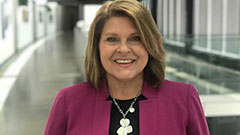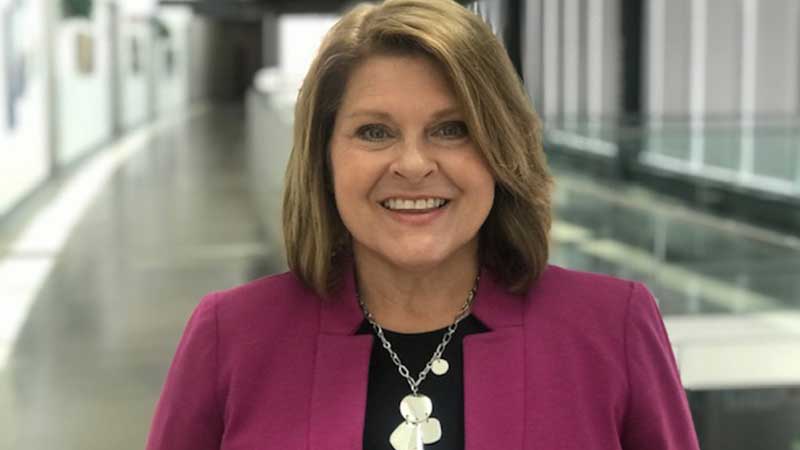Catalysts for change often work quietly, but their results speak loud and clear. At education organizations, they’re the people who build strong relationships across stakeholders, support and empower others to design and drive the work, and embrace a “student first” orientation to center students’ needs and aspirations over institutions’.
These “catalysts” work to achieve policy and practice changes in postsecondary education through partnerships across Indiana, Tennessee, and New York, a report from Lumina Foundation’s partners at Equal Measure shows. These changes include expanding and systematizing the use of credit for prior learning, setting up a Reconnect Café for students to access on- and off-campus resources, and making industry-recognized certifications the first stackable credential in earning a degree.
In short, catalysts play outsized roles in driving equitable changes to help adult students learn, earn, and succeed.

I recently sat down with Kathy Huffman to learn more about how she earned her catalyst designation. As director of employer engagement at Community Education Coalition in Columbus, Ind., she connects partners across a 10-county region to help adults eager to earn college credentials.
How did you get started?
Kathy Huffman: Really, it was about getting the partners to come together and set some shared goals. At the time, they didn’t see how working together could benefit them, so the first piece was coming up with that shared goal: What can we do together that we can’t do by ourselves?
What’s it like to be a catalyst for change in education?
KH: The work of a catalyst is often invisible. It’s behind the scenes as a facilitator, convener, and visionary. It’s not easily measured. It’s about building relationships. My role is pulling folks together and creating this common vision and shared strategies. It allowed us to do a whole lot more than we had been doing. Without a catalyst, that work really struggles. You must have somebody dedicated to that invisible relationship-communicator-convener role for change to really accelerate.
What policy and practice changes are you most proud of facilitating?
KH: We hit our target of increasing the number of people earning credentials annually in the first year. It was like a 1,000-person increase, which is a lot for a small community. By year four, we had increased credential earners by 68 percent, and this was during a pandemic! By the time the pandemic hit, everyone was so well-connected we were able to use those relationships to implement strategies and still be successful.
What roadblocks did you overcome?
KH: One potential roadblock was asking partners to share data. I mean, the data doesn’t belong to me; it belongs to them. That level of trust has to be there, but without the data, we wouldn’t have been able to tell if we were making a difference.
How are you helping Latino and low-income students, who are the heart of your mission?
KH: The Bilingual Student Success Coach role at Ivy Tech Community College in Columbus is now a full-time position. And it’s completely absorbed into the college and part of how they support students. Also, we’re proud of the expansion of English as a Second Language (ESL) classes at the McDowell Education Center for adult learners in Columbus. That might not sound like a lot, but it’s the first step and a really important component on the path to education and training.
In working for equity, who are we still not reaching?
KH: Within our regional work we are not yet reaching Black and biracial youth. It is a very small population in our community that we have not focused on until recently. But we are learning more and more about the challenges in closing the educational equity gaps and beginning to discuss what we might do to improve outcomes.
What advice would you give others with similar goals?
KH: When you go to the partners, don’t act like you have all the answers because you really don’t. Take time to understand the system. You really have to dig into it—like a year spent just trying to understand the system. Then you can connect with your partners with a high level of trust. Also, you can’t wait for people to come to you. You need to get out there, meet them, understand their needs, and find that link between what they’re trying to accomplish and how it fits into this larger regional initiative. Then you start to get that buy-in.
The results prove it: students do better when catalysts like Kathy Huffman bring people and systems together to speed much-needed change. More progress is on the way.
[Wendy Sedlak, Ph.D., is strategy director for research and evaluation at Lumina Foundation, an independent foundation that strives for racial equity as it helps all Americans keep learning beyond high school. She synthesizes data and evidence to guide Lumina’s strategy and measure its progress. Kathy Huffman is director of employer engagement at Community Education Coalition in Columbus, Indiana. She works to improve learning opportunities for all adults, especially Latino and low-income students facing systemic barriers. Equal Measure partners with Lumina Foundation to advance social change and measure results.]
